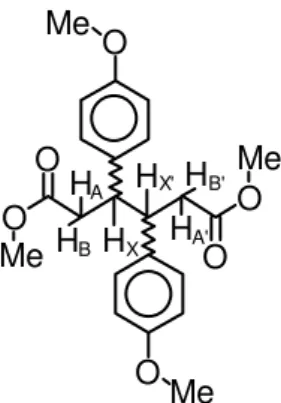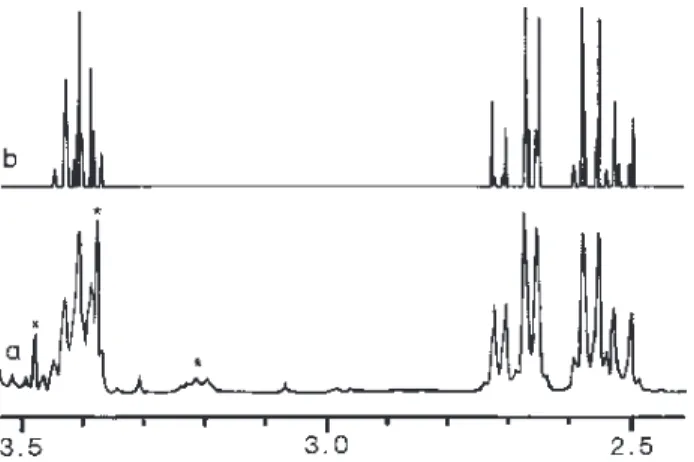324 Campos et al. J. Braz. Chem. Soc
Short Report
Differentiation Between the
like
and
unlike
Isomers of
Dimethyl 3,4-di(
p
-anisyl)adipate Using
1H NMR Spectroscopy
Ivan P. de A. Camposa*, Solange K. Sakatab, Hans Viertlerb and Vera L. Pardinib
a
Instituto de Ciências Exatas e Tecnologia, Universidade Paulista, Av. Alphaville, 3500, 06500-000, Santana de Parnaíba - SP, Brazil, b
Depto. de Química Fundamental, Instituto de Química, Universidade de São Paulo, CP 26077, 05513-970, São Paulo - SP, Brazil.
Apresenta-se aqui a diferenciação entre os isômeros like (igual) e unlike (diferente) do 3,4-di (p-anisil)adipato de dimetila, que foi efetuada pelo uso combinado de espectroscopia de RMN de 1H,
simulação espectral e Mecânica Molecular, correlacionados pelo uso da Equação de Altona, uma versão generalizada da Equação de Karplus.
The differentiation between the like and unlike isomers of the title compound, achieved by combined use of 1H NMR spectroscopy, spectral simulation and Molecular Mechanics, correlated
by means of the Altona Equation (a generalized version of the Karplus Equation), is reported herein.
Keywords: like and unlike diastereomers, Altona Equation, stereochemical analysis by NMR, stereochemical analysis.
*e-mail: ipdacamp@iq.usp.br
Introduction
The electrohydrodimerization1 of olefin derivatives is a versatile reaction, which has attracted considerable inter-est in recent years.
In the course of an investigation2 on the electrochemical reduction of substituted cinnamic esters, we have prepared and isolated both diastereomers of dimethyl 3,4-di(p -anisyl)adipate (dAA, Figure 1). At that point, however, we still had the problem of discerning the unlike3(meso)compound from the like3isomer racemate. As outlined below, we have accomplished this objective by employing well-established procedures but, to our knowledge, this approach has never been applied to the stereochemical analysis of open-chain molecules, such as substituted adipic acid derivatives.
Results and Discussion
After acquisition of the 300 MHz 1H NMR spectrum from each sample (in CDCl3, at room temperature), we no-ticed that although both presented the expected4 AA’BB’XX’ second-order sub-spectra (Figures 1, 2a and 3), besides the methoxy singlets and the signals due to the
aromatic protons, only one of them (henceforward denoted as Sample I) presented this AA’BB’XX’ sub-spectrum suffi-ciently well resolved for further analysis (Figure 2a).
Hence, after having measured J(AX) = J(A’X’) = 8.55 Hz, J(BX) = J(B’X’) = 6.20 Hz and δ(X) = 3.411, by assuming that J(A’X) ≈ J(AX’) ≈ J(B’X) ≈ J(BX’) » J(AA’) ≈ J(AB’) ≈ J(A’B) ≈ J(BB’) ≈ 0 Hz (see Figure 2a), the AA’BB’ part of the AA’BB’XX’ sub-spectrum is amenable to direct solu-tion5, on taking the centers of the doublets (due to cou-pling to either the X or the X’ nuclei) as the four lines of an AB system, this procedure yielding: δ(A) = 2.548, δ(B) = 2.688 and J(AB) = J(A’B’) = 15.43 Hz.
O Me
O
O O Me
O O
Me Me
HA' HA
HBHX HX'HB'
Figure 1. Representation of dAA, highlighting the protons of the AA’BB’XX’ sub-system.
J. Braz. Chem. Soc., Vol. 11, No. 3, 324-327, 2000. Printed in Brazil
Vol. 11 No. 3, 2000 Differentiation between the like and unlike isomers of dimethyl 3,4-di(p-anisyl) 325
Using the above data, together with the measured posi-tions of the 15 observed lines, as input for the program LAOCOON 36, we have obtained a very good fit (Figure 2b, RMS Error = 0.0012 Hz) for the 208 calculated lines, together with the calculated value for J(XX’) = 5.06 Hz. This value was, then, converted to a 46° dihedral angle (Hx–C– C–Hx’) for Sample I, by using the Altona Equation7 (a gen-eralized version of the Karplus Equation).
Now, to be able to distinguish between the diastereomers of dAA, an acyclic compound, two conditions must be met: each isomer must have only one strongly preferred rotamer, and these two rotamers must present different Hx–C–C–Hx’ dihedral angles.
Thus, we have performed Molecular Mechanics calcu-lations (MM+, Hyperchem 3) and found that both above conditions are met, each diastereomer strongly favoring the rotamer with distal p-anisyl groups, represented in Figure 4, below.
Hence we concluded that Sample I is the l-dAA. It should be pointed out that this assignment was only possible because these compounds present second-order sub-spec-tra: were it otherwise, it would be impossible to obtain the values of the coupling constants between the protons on each side of the relevant symmetry element.
It should be added that X-ray Diffraction analysis results8 on a crystal obtained from Sample II shows it to be the unlike isomer, thus confirming our conclusion regarding Sample I. Furthermore, the X-ray data show a dihedral angle (CH2 -C-C-CH2) of 177.51° for the u-dAA (in a monocrystal), which is near enough the 171.50° value our MM+ calculations yielded for the same angle (for one molecule alone in the vacuum) and thus confirms both the accuracy of our calculations and the very strong preference presented by dAA isomers for the rotamers with distal p-anisyl groups.
Experimental
Materials
Deuterochloroform and methyl p-methoxycinnamate were used as received from Aldrich, after being checked for purity. Both isomers of dimethyl 3,4-di(p-anisyl) adipate (dAA) were simultaneously formed by cathodic reduction of methyl p-methoxycinnamate in methanol, using either platinum or mercury cathodes and TEAB as support electrolyte, as described elsewhere2,9,10. The iso-mers of dAA were subsequently resolved and purified by column chromatography on silica-gel 60. The complete assigned 1H and 13C NMR dataset for these compounds is presented in Table 1, below. The HETCOR (1H-13C) ex-periments were performed in order to assure the internal consistency of the assignments here presented.
Figure 2. The experimental (a) and simulated (b) AA’BB’XX’ sub-spectra (at 300.13 MHz) of l-dAA (the signals marked with * are due to ca. 10% of u-dAA present in the sample, while that marked with x is due to an unidentified inpurity).
Figure 3. The experimental AA’BB’XX’ sub-spectrum (at 300.13 MHz) of u-dAA.
Figure 4. The two diastereomers of dAA, as calculated by MM+.
(Hx-C-C-Hx’)=45.0º (
>
C2
CH2
CO2Me H
CH2
MeO CO2Me
OMe
H
like or S*/ S*
=> protons are homotopic
x
x'
like or S*/S* H
H
CH2
MeO CO2Me
OMe
H2C MeO2C
unlike or S*/ R*
=> protons are enantiotopic σ
x
x'
(Hx-C-C-Hx’)=171.5º (
>
326 Campos et al. J. Braz. Chem. Soc
Instruments and Methods
1H and 13C NMR spectra were recorded on a Bruker Avance DPX 300 instrument. Standard microprograms from Bruker Software Library were employed. All measurements were performed in 5 mm o.d. tubes, using a deuterium lock, at 20oC. Samples were prepared by dissolving ca. 5% v/v of each compound in 0.5 mL of CDCl3, containing 0.01 % v/v of TMS as internal standard.
1H spectra (300.13 MHz) were acquired with a sweep width 2250 Hz, corresponding to a final digital resolu-tion 0.137 Hz per data point. 32 scans were accumulated, using a pulse duration of ca. 15º, with an acquisition time ≥ 7.4 s and a 10.0 s relaxation delay.
Broadband 1H decoupled 13C spectra (75.47 MHz), were acquired with a sweep width ≥ 8000 Hz, correspond-ing to a final digital resolution ≥ 0.488 Hz per data point. 64 scans were accumulated, using a pulse duration of ca. 36º, with an acquisition time ≥ 1.0 s and no relaxation delay. Raw data were zero-filled and Fourier transformed under matched-filter conditions.
HETCOR (1H-13C) experiments11 were performed at 7.05 T, using a low decoupler power in CW mode (1.5 W) and composite pulse decoupling (CPD) with polarization
transfer from 1H to 13C. The following pulse sequence was employed:
1H: D
0 - 90x° - D0- - D0- D3 - 90y° - - CPD 13C: D
1 - 180x° - - 90x° - D4 - FID
where:
D1 = 2 s; D3 = 4 ms; D4 = 2 ms; D0 = (3 + 178.6 n) µs and 0 ≤n≤ 512.
The FIDs for the 2D experiments were acquired with ca. 8000 Hz of sweep width in F2; 32 scans were accumu-lated, with an acquisition time of 1.5 s; 512 such experi-ments were performed with the evolution time incremented so as to provide an effective sweep width of ca. 2800 Hz in F1. The delays D3 and D4 were chosen to show correlations with peaks of all multiplicities by as-suming a J(CH) of ca. 125 Hz. The final data matrix was 512 x 4 Kbytes. Raw data were zero-filled in F1 and a gaussian window function was applied in both F1 and F2 prior to Fourier transformation.
Acknowledgments
Thanks are due to CAPES and UNIP for financial sup-port, to Ms. M. Link for helping with the figures and to Professor H. Chaimovich, for the use of Hyperchem 3.
References
1. Utley, J. P. H. Chem. Soc. Rev., 1997, 26, 157. 2. Sakata, S. K. Tese de Doutoramento, IQ-USP, São
Paulo, 1998, p. 73.
3. Moss, G. P. Pure Appl. Chem.1996, 68, 2193. 4. Jennings, W. B. Chem. Rev.1975, 75, 307.
5. Günther, H. NMR Spectroscopy, 2nd. ed., Wiley, Chichester, UK, 1995, p. 162.
6. (a) Lopes, J. C. D. Abstracts of the III Jornada Brasileira de Ressonância Magnética, AUREMN, São Table 1. Assigned NMR Data from the Isomers of Dimethyl 3,4-Di(p-Anisyl)Adipate
a) 300.13 MHz 1H NMR δ (multiplicity) of dAA Isomers in CDCl
3 (TMS = 0)
isomer H-metaa H-ortoa MeOb MeOC=O H
x/Hx’c HB/HB’c HA/HA’c unlike 7.18 (dd) 6.86 (dd) 3.79 (s) 3.38 (s) 3.22 (me) 2.39 (me) 2.37 (me) like 6.77 (df) 6.72 (df) 3.76 (s) 3.56 (s) 3.41 (mg) 2.69 (mg) 2.55 (mg) aPositions relative to the MeO group in the anisyl moiety; bAttached to the p-anisyl moiety; cSee Figure 1; dJ = 5.79 Hz; eThe coupling constants of this AA’BB’XX’ system were not determined due to insufficient resolution; fJ = 5.94 Hz; gFor the coupling constants of this AA’BB’XX’ system see Table 2.
b) 75.47 MHz 13C NMR δ of dAA Isomers in CDCl
3 (TMS = 0)
isomer C-ipsoa C-paraa C-ortoa C-metaa MeOb MeOC=O CH CH
2 C=O
unlike 158.51 133.76 114.02 129.02 55.18 51.28 47.11 39.83 172.58
like 158.27 131.88 113.12 129.82 55.10 51.56 45.43 38.00 172.61
a Positions relative to the MeO group in the anisyl moiety; bAttached to the p-anisyl moiety.
Table 2. Values of the 1H NMR Scalar Coupling Constants for l-dAA. Coupling Constants Values / Hz
J(X,A) = J(X’,A’) = 8.55a
J(X,B) = J(X’,B’) = 6.20a
J(A,B) = J(A’,B’) = –15.43b
J(X,X’) = 5.06c
J(A,A’) = 0.03c
J(B,B’) = 0.01c
Vol. 11 No. 3, 2000 Differentiation between the like and unlike isomers of dimethyl 3,4-di(p-anisyl) 327
Carlos, SP, Brazil, 1994, p. 91. (b) Castellano, S.; Bothner-By, A. A. J. Chem. Phys. 1964, 41, 3863. (c) Castellano, S.; Bothner-By, A. A. Computer Programs for Chemistry, DeTar, D. F., Ed.; Benjamin, New York, Vol. I, 1968.
7. (a) Cerda-Garcia-Rojas, C. M.; Zapeda, M. G.; Nathan, P. J. Tetrahedron Comput. Methodol., 1990, 3, 113. (b) Haasnoot, C. A. G.; de Leeuw, F. A. A. M.;
Altona, C. Tetrahedron, 1980, 26, 2783.
8. Gambardella, M. T. P.; Sakata, S. K.; Viertler, H.; Pardini, V. L. (unplublished results).
9. Nishiguchi, I.; Hirashima, T. Angew. Chem. Suppl.
1983, 70.
10. Fussing, I.; Hammerich, O.; Hussain, A.; Nielsen, W. F.; Utley, J. P. H. Acta Chim. Scand., 1998, 52, 328. 11. Bax, A.; Morris, G. J. Magn. Reson.1981, 42, 501.
Received: June 07, 1999


